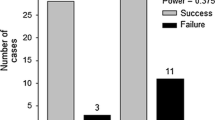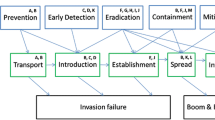Abstract
The invasive marine alga Caulerpa taxifolia was discovered June 12, 2000, in California at Agua Hedionda Lagoon. Due to a 15-year history of spread in the Mediterranean Sea, C. taxifolia had already been placed on the US Federal Noxious Weed list in 1999. Awareness of this threat greatly facilitated consensus building and setting clear eradication goals among a large number of state, federal and local agencies as well as private groups and non-governmental organizations (NGOs) that became the ‘Southern California Caulerpa Action Team’ (SCCAT). Field containment and treatments began 17 days after the discovery due to: (1) timely identification and notification of the infestation; (2) the proactive staff of the San Diego Regional Water Quality Control Board who deemed this invasion tantamount to an ‘oil spill’, thus freeing up emergency funding; (3) the mobilization of diver crews already working at the site. Three well-integrated components of this rapid response have resulted in an effective eradication program: (a) expertise and knowledge on the biology of C. taxifolia; (b) knowledge on the uses, ‘ownership’ and characteristics of the infested site; (c) knowledge and experience in the implementation of aquatic plant eradication. Together, with the requisite resources (approximately $US1.2 million per year), this approach has resulted in containment, treatment and excellent progress toward eradication of C. taxifolia. Successful rapid response to other aquatic invasive species will require similar readiness to act, and immediate access to adequate funding.
Similar content being viewed by others
References
LWJ Anderson (2001) ArticleTitleCaulerpa taxifolia: new marine algal invader in US Waters Aquatic Invaders 12 1–6
Anderson LWJ (2002)Caulerpa taxifolia in the United States: rapid response and eradication program. Proc. Internatl. Caulerpa taxifolia Conf. San Diego, CA, California Sea Grant Publication No. T–047
Anderson LWJ (2003) Assessment of Caulerpa taxifolia viability in sediment from Agua Hedionda Lagoon Eradication Treatments. Final Report to California Dept. of Fish and Game, 25 pp
LWJ Anderson S Keppner (2001) ArticleTitleCaulerpa taxifolia: marine algal invader provokes quick response in US waters Aquatic Nuisance Spec Digest 2 13–23
California Department of Fish and Game (2000) Managing Northern Pike at Lake Davis: A Plan for Y2000. Prepared by the Save Lake Davis Task Force Steering Committee and the California Department of Fish and Game, February 2000. 24 pp with appendices. Website: http://www.dfg.ca.gov/northernpike/mgpike.htm
California Department of Fish and Game (2002) Caulerpa taxifolia scientific Review Panel Report, 26 pp
California Department of Food and Agriculture (2003) Annual Report of the Hydrilla Eradication Program 2001–2002. Website: http://www.cdfa.ca.gov/phpps/ipc/hydrilla/hydrilla_rpt2001-2002.htm
California Sea Grant College Program (2002) International Caulerpa taxifolia conference proceedings. In: Williams E and Grosholz E (eds) California Sea Grant Pub. No. T–047
Culver CS , Kuris AM and Beede B (1997) Identification and management of the exotic sabellid pest in California cultured abalone. Pub. T-041, California Sea Grant College System, La Jolla, California
CS Culver AM Kuris (2000) ArticleTitleThe apparent eradication of a locally established introduced marine pest Biological Invasions 2 245–253 Occurrence Handle10.1023/A:1010082407254
R Dalton (2000) ArticleTitleResearchers criticize response to killer algae Nature 406 447 Occurrence Handle10.1038/35020226
R Dalton (2001) ArticleTitleAction Urged to combat killer algae Nature 412 260 Occurrence Handle10.1038/35085712
FICMNEW (Federal Interagency Committee for the Management of Noxious and Exotic Weeds) (2003) A national early detection and rapid response system for invasive plants in the United States: Conceptual Design, 24 pp (http://ficmnew.fws.gov)
N Goedde (1998) ArticleTitleThe poisoning of Lake Davis: weighing the risks Environs 21 3–24
O Jousson J Pawlowski L Zaninetti FW Zechman F Dini G Guiseppe ParticleDi R Woodfield A Millar A Meinesz (2001) ArticleTitleInvasive alga reaches California Nature 408 175–158
SM Keppner RT Caplen (1999) A Prevention Program for the Mediterranean Strain of Caulerpa taxifolia US Fish and Wildlife Service Lower, Great Lakes Fishery Resources Office Amherst, NY
S Keppner M Weimer WJ Troxel (1998) Caulerpa taxifolia: A Potential Threat to US Coastal Waters US Fish and Wildlife Service, Lower Great Lakes Fishery Resources Office Amherst, NY
AM Kuris CS Culver (1999) ArticleTitleAn introduced sabellid polychate pest infesting cultured abalones and its potential spread to other California gastropods Invertebrate Biology 118 391–403
Lee DP (2001) Northern Pike Control at Lake Davis, California. In: Cailteux RL, DeMong L, Finlayson BJ, Horton W, McClay W, Schnick RA , Thompson C (ed). Rotenone in Fisheries: Are the Rewards Worth the Risk? American Fisheries Society. Trends in Fisheries Science and Management 1, pp. 55–61, Bethesda, Maryland
Meinesz A (1999) Killer Algae Univ. Chicago Press, 360 pp. (translated by Daniel Simberloff)
Meinesz A (2002) Killer Algae, 2nd edn, Univ. Chicago Press (translated by Daniel Simberloff)
Mullin BH, Anderson LWJ, Ditomaso JM, Eplee RE, Getsinger KD (2000) Invasive Plant Species. Council for Agricultural Science and Technology (CAST) Issue Paper No. 13, 18 pp
National Invasive Species Council (2003) General Guidelines for establishment and evaluation of invasive species early detection and rapid response systems. Version I, 16 pp. National Invasive Species Council, Washington, DC
Western Regional Panel on Invasvive Aquatic Weeds (2003) Draft Rapid Response Plan. Website: http://answest.fws.gov
S Williams ED Groscholtz (2002) ArticleTitlePreliminary reports from the Caulerpa taxifolia invasion in southern California Marine Ecol. Progr. Ser. 233 307–310
Williams SL,, Schroeder S (2003) Eradication of the invasive seaweed Caulerpa taxifolia by chlorine bleach. Final Report to California Dept. of Fish and Game, 25 pp
SL Williams S Schroeder (2004) ArticleTitleEradication of the invasive seaweed Caulerpa taxifolia by chlorine bleach Marine Ecology Prog. Ser. 272 69–76
Author information
Authors and Affiliations
Corresponding author
Additional information
The US Government’s right to retain a non-exclusive, royalty-free licence in and to any copyright is acknowledged.
Rights and permissions
About this article
Cite this article
Anderson, L.W.J. California’s Reaction to Caulerpa taxifolia: A Model for Invasive Species Rapid Response*. Biol Invasions 7, 1003–1016 (2005). https://doi.org/10.1007/s10530-004-3123-z
Received:
Accepted:
Issue Date:
DOI: https://doi.org/10.1007/s10530-004-3123-z




